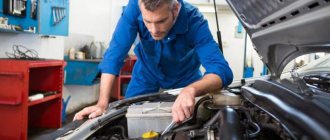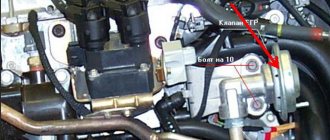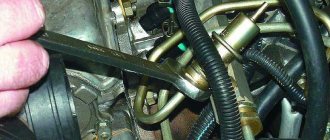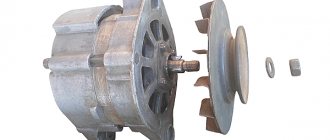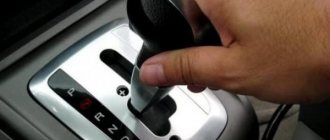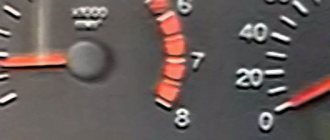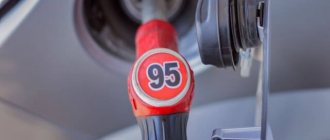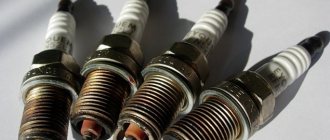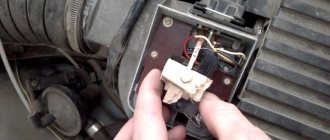Checking VAZ-2107
Now let's take a closer look at how to identify the cause of such a malfunction on different car models.
The first will be the carburetor VAZ-2107; there are plenty of cases when the car suddenly starts to jerk while driving.
- First you need to inspect all pipes of the system for cracks;
- Open the tank. It happens that in the summer the lid fits very tightly to the neck, blocking the access of air to the tank. When moving, the pump works and creates a vacuum in the tank, due to which the same pump is then unable to “pull” fuel. It seems like a small thing, but this also happens;
- Inspect the fuel filter located in the pipes leading to the fuel pump. These filters are transparent and easy to visually evaluate;
- You can also check the fuel pump without removing it. It is necessary to disconnect the pipeline coming from the pump from the carburetor and lower its end into some container. Then manually pump the pump into action and evaluate how it pumps fuel - it should supply it in even portions;
- While the fuel pipe is disconnected from the carburetor, unscrew the fitting on which the fuel line fits and remove the small mesh filter, clean it and reinstall it;
- Next comes the carburetor. It is advisable to remove it from the car, rinse it thoroughly, and inspect the accelerator pump membrane.
If actions with the fuel system did not help, we proceed to checking the ignition system.
We unscrew the spark plugs, check their functionality, and replace them if necessary; We check the system wiring for breakdown. This can be done this way - in the dark or in a closed garage (the main thing is that it is dark), open the hood and start the engine. If there are voltage losses on the wiring, they will be immediately noticeable by the sparks that form. Next, we replace the wiring that “breaks through” and check the wire connections; Next, we check the distributor, there should be no signs of critical wear, it should be dry under the cover. Be sure to inspect the centrifugal regulator, and also check the vacuum regulator. You should check whether there is a vacuum in the pipe leading to it. Then the Hall sensor, coil and switch will be checked for functionality. You can do this yourself if you have the necessary equipment at hand, but you need to know how to check them
But you can contact an auto electrician. It is also important not to forget to check that the ignition is installed correctly.
This is in general and all the features of identifying the cause of uneven running on the VAZ-2107.
Is it due to the fuel filter?
So, it has been determined that the car jerks only under certain conditions. The fuel system pipes are all normal, but it is believed that the cause lies in the fuel system.
This means that the filters need to be checked next. Often it is because of them that this malfunction appears.
The task of any filter element in the fuel system is to clean the fuel from impurities, but at the same time, these impurities do not disappear anywhere, they remain in the filter itself.
Over time, it becomes so clogged with impurities and dirt that its throughput drops, and greatly.
As a result, the fuel pump pumps as expected, but the fuel does not have time to pass through the filter elements and the engine begins to “starve”, accompanied by the car jerking. There is only one way out here - .
If you take into account a carburetor car, then the number of filters it has is 2-3 pieces, but one of them, the usual mesh on the fuel receiver, can be practically discounted.
This mesh is aimed only at catching large particles, so it is practically incapable of becoming clogged to such an extent that it stops the flow of fuel in the required quantity.
But the second filter, usually located in the pipelines leading to the fuel pump, is worth checking.
This filter is designed to capture smaller particles, and it is not difficult for it to become clogged.
The third filter is not available on all carbureted vehicles and is usually located at the fuel inlet to the carburetor. It is also a regular mesh, but only fine.
This filter itself is small, so it often gets clogged.
Older machines had another filter installed - a coarse filter, also known as a sediment filter.
The design of this filter is such that it is not capable of becoming clogged to such an extent that it will not allow fuel to pass through. But this filter will subsequently cause rapid clogging of the fine filter.
If this filter accumulates a large amount of debris and dirt, then eventually it will not begin to clean the fuel from impurities, but, on the contrary, will begin to add them.
Injection car filters.
Most modern injection cars are also equipped with three filters. The first of them is a mesh for catching large particles installed in the neck of the tank. This mesh is clearly not the cause of the twitching.
The second filter is located on the fuel pump installed in the tank. This filter is also often a mesh, only with smaller cells; its task is to prevent large debris from entering the fuel pump.
Typical faults
Let's look at the most classic injuries.
- Increased fuel consumption may indicate clogged injectors. Their nozzle has a small diameter, and even the slightest contamination can lead to disruption of the mixture formation process. Thus, the percentage of efficiency decreases.
- Lack of fuel fluid in the system. The presence of this symptom indicates that the problem is not only in the injectors themselves, but also in other elements working in tandem with them.
- The XX injector mode is unstable. This sign may indicate many problems.
- Difficulty starting the engine.
- Trouble in the system resulting from a faulty cylinder/s.
- Fuel overflow in the system.
A clogged injector nozzle is unable to inject the required amount of gasoline or diesel fuel. As a result, a significant amount of fuel burns out in the manifold, and this leads not only to an increase in consumption, but also to other malfunctions - loss of power characteristics, increased load on the electronics, failure of the ignition module, spark plugs, armor wiring, etc.
Normal and clogged injector nozzle
When little fuel enters the system, this may indicate a failure of the fuel pump. The latter, in many cases, is simply installed crookedly in the process of amateurishly carried out repair work. In many cases, the fuel pump simply becomes clogged and needs to be cleaned.
The most compelling reason for unstable operation of the idle mode is a malfunction of the IAC sensor. In some cases, the throttle surface may become clogged.
Engine starting problems are usually caused by a lack of spark. To quickly check this, it is recommended to use a spark gap. Experts do not recommend checking the spark for a break, as this may negatively affect the operation of the ignition module and controller.
Trouble on the injector occurs due to poorly functioning cylinders of the power unit. The problem is resolved only after identifying non-working elements. Then you need to disassemble the motor and replace the required parts.
Fuel fluid in the Gazelle injector overflows, as a rule, due to a faulty sensor responsible for the position of the damper.
Article on the topic: Muscle cars from America: power, style and speed from the past
Thus, all the problems listed above need to be fixed quickly. As mentioned above, it is worth doing self-adjustment only in two cases: if you have a lot of experience and if there are no normal specialists nearby. Do-it-yourself repairs can be carried out using competent instructions and master classes. There are a lot of them on the Internet today.
Injector repair at a service station
The advantage of high-quality service stations, in addition to the high professionalism of the workers, is that they have high-tech equipment. In addition to helping to clean the injectors, the equipment makes it possible to conduct comprehensive diagnostics. For example, using the device, you can easily identify needle wear and the actual performance of a particular injector.
It was said above that problems due to low-quality fuel are considered the most common in the countries of the post-Soviet space. And this is true, because fuel with a high percentage of foreign impurities and debris a priori contributes to the formation of soot, which clogs the injector nozzles over time.
Other elements of the fuel system
Now on to other elements of the fuel system.
The next culprit for uneven running may be the fuel pump.
In carburetor cars.
A mechanically driven diaphragm fuel pump is often used here.
So, even a small rupture of the membrane will cause the pump’s performance to drop sharply.
The pump valves may also be to blame. They can easily break the sealing of the device’s chambers, which leads to a drop in fuel supply.
The fuel pump can also cause jerking. On such cars, since the pump is located in the tank, it is electrically driven.
A decrease in device performance leads to the problem described in this article. Here you need to consider a specific case separately.
Now directly about the carburetor.
Because of this, uneven running of the car is also possible. Often such a malfunction occurs due to severe clogging. Debris and dirt can block channels, forget jets, etc.
Sometimes the reason lies in the accelerator pump. A diaphragm accelerator pump is installed on carburetors, the task of which is to increase the fuel supply when the gas pedal is sharply pressed.
But if the membrane is torn, then the accelerator pump will not be able to increase the supply of gasoline, and hence fuel starvation.
For injectors, the fuel injectors are checked next. Violation of their performance leads to jerking of the car.
Injectors need to be cleaned periodically, in principle, like everything else.
Also, in an injection car, the functionality of all sensors involved in the operation of the power system is checked, and then the electronic control unit is checked.
What to do if a VAZ car jerks when driving, troubleshooting
On various automobile forums, the question is often asked: “What should I do if my VAZ car twitches?” Experts distinguish three main types of such jerks. Firstly, this is when the car begins to twitch at the beginning of the movement, secondly, jerking begins as soon as the car begins to accelerate and, thirdly, the car continues its smooth, steady motion, and suddenly begins to move with jerks.
In the first case, most often the cause of the problem is a loss of power (not counting the fact that the car may jerk due to a cold engine). Most often this happens either due to problems with the accelerator pump, or you need to check the condition of the vacuum corrector of the ignition distributor. In order to do this, it is necessary to remove the accelerator pump nozzle and thoroughly blow it out. If a fault is found in the vacuum corrector, you will simply have to replace it. If these steps do not help, you need to turn out and check the spark plugs, and if necessary, replace them.
If the car begins to twitch during acceleration, there may be several reasons. This could be a clogged engine, a faulty fuel pump, or a clogged additional fuel filter. Another reason could be a malfunction of the ignition system. Low gasoline levels can also cause the car to jerk when accelerating. First of all, you need to remove the air filter and carburetor cover. After this, you need to check the fuel level (in normal condition it should be 22 millimeters below the partition line of the carburetor cover and body).
If the fuel level is not on this line, then it needs to be adjusted by bending the float. Thus, it is necessary to increase the gap between the floats and the cover gasket to 2 millimeters. Be sure to rinse and strongly blow out the carburetor filter. If it turns out that it is very dirty, it needs to be replaced. Also, the additional fuel filter must be checked; if necessary, it must also be replaced. After all that has been done, you need to try to drive, but if the jerking does not stop, then the reason is a malfunction of the fuel pump or ignition system. You can replace the spark plugs and change the fuel filter yourself.
If jerking suddenly occurs during steady-state driving, the first cause of this problem may be a malfunction of the ignition system. There are only a few things you can do on your own. You need to start by inspecting the space under the hood to check the integrity of the connectors and the condition of the connectors. After which you need to start the engine in the dark and carefully look to see if there is a spark somewhere, that is, if there is a breakdown in the high-voltage wires to ground. In addition, you need to replace all spark plugs, even those that look normal or were installed not so long ago.
Source
How to find out the causes of the malfunction
- You will need two wrenches - "eight" and "ten", straight and Phillips screwdrivers, a clean rag, some copper wire. The wire diameter should be thinner than 0.3 mm.
- In addition, you will need a compressor and WD40 fluid.
The operating procedure is as follows:
- Armed with a ten key, remove the cover from the air filter housing by unfastening the spring fasteners. Remove the filter. Using an eight wrench, unscrew the nuts and you can now loosen the clamp on the crankcase ventilation hose where it connects to the valve cover. After this, you can remove the filter housing.
- Now you need to remove the vacuum corrector drive hose and create a vacuum to make sure it is tight.
- The corrector may need to be replaced. It’s better to entrust this to the car service workers.
- If air cannot flow freely during purging, then look at how things are going with the carburetor. For example, make sure its air damper is open. When you press the throttle lever, a stream of gasoline should come out of the nozzle. Make sure they are there and the fuel spray direction is correct.
- In case of any problems, the car must be sent for service.
- Carefully remove the hose leading the fuel to the carburetor, without spilling gasoline. We do the same with the choke control cable, and then with the wire that is located on the idle air solenoid valve. Now unscrew the screws securing the top carburetor cover. After removing the lid, place it with the floats facing up so as not to damage it.
- Now, using a screwdriver, carefully pry up the nozzle tubes and pull it out of the socket.
- After you do this, you need to take a thin copper wire and carefully clean the holes in the spray nozzle. Then you should blow it in the opposite direction (against the movement of fuel).
- We install the sprayer. In this case, without closing the carburetor cover, you need to press the damper drive lever. We check the appearance of streams of fuel running from the nozzle tubes.
- We assemble the carburetor.
- If there were no streams, then you need to check how easily the accelerator pump drive lever moves. We also check whether there is any play in the drive. If necessary, we lubricate it with WD40 and replace everything that is faulty.
- Let's check the streams again. If they are, we assemble the carburetor. If not, we go to the service center.
If the VAZ 2109 carburetor jerks during acceleration
Here the list of possible reasons is also extensive. This is both a malfunction of the fuel filter and the possibility of a low fuel level. It is also possible that the fuel pump is not working correctly, or the additional fuel filter is clogged. It could also be an ignition problem. It’s better not to delay and seek professional diagnostics.
You can also read on this topic:
Tuning Renault Sandero and some modifications on your own
The car exhaust system allows you to get rid of exhaust gases
High fuel consumption of VAZ 2109 (carburetor), what to do?
The instrument panel of the VAZ 2114 looks great and hardly breaks
Tuning VAZ 2111 – elegance and comfort of the car
Alex S January 8th, 2014
Published in: Useful tips and car devices
Tags: Advice for motorists
Removal and installation of distributor VAZ-2107, 2104, 2105, 2106
Preparation
Before installing a new VAZ-2107 distributor for a contact ignition system, you need to adjust the gap between the contacts of the breaker. It is more convenient to do this with the device removed from the car. We check the gap with a flat feeler gauge. The value is set from 0.35 to 0.45 mm. In this case, the protrusion of the cam should move the moving contact away from the stationary contact as much as possible. We adjust by slightly loosening the screws, and then tighten them more firmly and check the gap again. Contacts that have worked hard may have a protrusion on one and a depression on the other, which interferes with adjustment. You can get around this problem by grinding off the protrusion with a needle file. It is better not to use sandpaper, because... small particles of abrasive will definitely “eat” into the surface and interfere with the operation of the contacts.
Before removing the old distributor, mark its position relative to the cylinder block with a marker. You also need to accurately mark the position of the moving contact (slider) relative to the body. If all this is not done, the settings will be violated and the engine will not start.
Installation
Having established exactly the same position of the roller in the body on the new distributor, carefully insert it into the hole in the block, slightly turning the roller to align the splines. Having “planted” the device in place by rotating the body relative to the block, we set the approximate advance angle, as on the old distributor. Secure with a washer and nut, but not too tight. Now you need to plug in the high voltage wires. This is easy to do - each contact on the distributor cover has the number of the cylinder to which it needs to be connected. We connect the wire from the ignition coil to the central terminal. The wires should fit tightly, with a slight tension, the protective caps should be pushed all the way down. Don’t get carried away, don’t bend the petals of the wire tips too much, otherwise later, when you try to remove them, you’ll tear off the wires “with their roots”! A wire goes from the contact wire to the “K” terminal of the ignition coil, usually it is green. If your VAZ-2107 is equipped with a contactless ignition system, then you need to connect a connector with three wires. Having plugged it into the socket, check the fit of the wires; it happens that they “crawl out” from their places and the device does not work. Everything is done, the new distributor is installed and ready to go. Let's try to start the engine. Started up? Great, that means everything was done correctly, all that remains is to check and slightly adjust the ignition timing.
Mass air flow sensor or crankshaft position sensor
Failure of these sensors can also cause the engine to run rough. Incorrect data on the amount of air entering the engine leads to incorrect opening times of the injectors and, as a result, incorrect preparation of the fuel mixture. The crankshaft position sensor can also cause confusion, due to which the moment of opening the injectors and the formation of a spark in the spark plugs will be chosen incorrectly. Hence the uneven operation of the engine with dips when picking up speed. Diagnostics will help determine the faulty sensor. This sensor will have to be replaced.
Why the engine jerks during acceleration: the main reasons
Let's start with the fact that most of the reasons why such deviations occur in the operation of internal combustion engines are often associated with the following systems:
- engine power system;
- internal combustion engine ignition system;
The culprit may be either the carburetor itself (dirty jets, incorrect settings, etc.) or the fuel pump. At the same time, we should not exclude the possibility that excess air is being sucked in somewhere, which causes the carburetor engine to jerk when accelerating the car.
As for modern injection engines, a number of common problems will be similar to engines with a carburetor. At the same time, problems that are characteristic exclusively of units with injection injection are also added to the list.
Let's focus on the possible causes of dips and jerks
First of all, let's start with the ignition system. As a rule, if problems arise in this system, there is a loss of power and the unit consumes more fuel. Usually spark plugs, high-voltage armored wires, and ignition coils fail. We also note that on injection cars the problem may lie in a faulty camshaft position sensor (CPR).
If no breakdown is detected, you should unscrew the spark plugs and inspect them. The electrodes must be intact, excessive carbon deposits are not allowed, the insulator must not have cracks, etc. Checks may also require armored wires. In some cases, after replacing the spark plugs and spark plug wires, the engine stops jerking during intense acceleration.
However, it happens that these methods do not bring the desired result. In such a case, it is necessary to check the camshaft position sensor separately.
Let us also add that the ignition timing (ignition timing, ignition timing) also deserves special attention. If the car jerks when accelerating, the ignition may be too early. On carburetor internal combustion engines, it is necessary to manually set the specified angle. On the injection unit, adjustment occurs automatically. However, we should not forget that interference with the factory firmware of the ECU (especially on cars with gas equipment) or problems with sensors can lead to malfunctions of the ignition system.
To quickly check the ignition timing, you need to accelerate the car to a speed of about 50 km/h. After this, a higher gear is engaged (for example, 4th), and then you will need to sharply press the gas pedal. Detonation will immediately appear in the engine, which should not last more than a couple of seconds with a normally adjusted OZ.
Now let's move on to the power system. At the very beginning, you should make sure that the fuel tank is filled with fuel suitable for the vehicle and meeting quality standards. Very often jerks and failures occur when low quality fuel was filled. In some cases, a “check” may also light up on the dashboard of fuel-injected cars.
Another element to check is the air filter. Its contamination will also lead to the fact that the unit will not receive enough air, which is necessary to prepare the fuel-air mixture.
If the filters are clean or new, but the jerks are repeated, then you need to move on to checking the injector. The first step is to diagnose the injection nozzles. Contamination of the injectors leads to the fact that the engine is not supplied with fuel, which is needed in afterburner mode in full.
To solve this problem, the nozzles are removed, then their performance, spray quality (flash shape), timely response to opening and closing, etc. are checked. The next step is to measure the fuel pressure in the fuel rail.
If the pressure is low, then the cause may be the fuel pressure regulator, a problem with the fuel line, or the fuel pump. As for the fuel pump, which is located in the tank, the device has its own separate mesh filter, which also becomes dirty over time.
As a result, the pump is not able to pump hotter into the ramp and maintain the required pressure with a sharply increasing load on the internal combustion engine. This reason is the most common in relation to jerks and dips when pressing the gas sharply. To solve this problem, it is necessary to remove the fuel pump, and also clean or replace the fuel pump strainer.
What causes the car to jerk when running at low speeds?
Since the car begins to twitch when reaching even low speeds, it will not be possible to immediately identify one specific problem. Problems may be hidden:
- In the engine fuel mixture supply system;
- In the vehicle ignition system;
- At the checkpoint;
- In the distributor design;
- Includes fuel filters;
- In the sparking system;
- In the control unit of the vehicle's on-board computer.
Let's go through the faults in each of the listed systems in detail.
Tip: When detecting a “jerking” behavior in the vehicle, the brakes may also squeak when braking. These 2 problems can be either interrelated or indicate completely different breakdowns.
Checking the engine fuel mixture supply system
Often the reason that the car jerks at low speeds is due to a malfunction of the power system. When the car starts to move, the cylinders simply cannot receive the required amount of fuel mixture, as a result of which the car is unable to transfer the required amount of power to the chassis for smooth driving and smooth commissioning of the transmission. As a result of increased pressure and transmission resistance, uneven running of the machine appears.
To solve this problem, it is recommended that you first pay attention to checking the throttle body. It also wouldn’t hurt to test and diagnose the performance of the sensors installed in the system for determining idle speed indicators. Do not forget to check the serviceability of the throttle valve position and the mass air flow sensor.
During diagnostics, most often a breakdown is found in the injectors responsible for uniform injection of the fuel mixture. In rare cases, engine jerking problems may be related to the air ducts that connect the injector receiver to the air filter structure. Here the problem lies in depressurization of connections and loss of pressure.
Malfunctions of the carburetor and other systems
The second most popular system that fails in the VAZ-2107 is the carburetor.
- First of all, check the idle air valve and jets. The valve needs to be replaced and the jets cleaned. Buy only high quality components so that they do not break down quickly.
- The second common malfunction of the carburetor unit is air getting into it. The place where it is sucked in can be found by visually inspecting the hoses. Most often, the thin hose of the vacuum corrector loses its seal. Many technicians recommend simply replacing all the hoses, since air can enter the carburetor through microcracks.
After checking the fuel system and carburetor, you need to pay attention to the distributor. Be sure to check the quality of the ignition contacts that distribute the impulse to the spark plugs
If the contact burns out, the engine will “triple”, “double”, and jerking will be felt while driving.
In the rarest cases, the car may move jerkily due to the spark plug failing soon. Typically, this behavior is unusual for this element of the ignition system, but car mechanics sometimes encounter this problem. The fact is that before failure, the spark plug begins to spark randomly, creating failures in ignition. The engine reacts to this with jerks and uneven running. Modern spark plugs most often do not behave this way; spark problems occur with inexpensive options with low quality.
Characters without spaces – 4468
Uniqueness of ETHT – 98%
Uniqueness of Text.ru – 100%
Academic nausea Advego–7.5%
Advego word frequency – 1.61%
Sometimes it happens that when driving, the car begins to twitch when the speed increases or when driving at a steady pace. At these moments, the driver can “boil” no worse than the engine itself. Moreover, when stopping and externally inspecting the engine, everything may look absolutely normal. The only correct behavior in this case is to drive and listen to the engine.
But for an inexperienced motorist, it is difficult to understand from the sound of the engine what is wrong with it. Therefore, below are the main reasons for this engine behavior and methods for eliminating them.
Failure in the ignition system
If no problem is found in the fuel supply system, you should look for it further - in the ignition system.
The first thing you should always do is check that the distributor is working properly. The quality of contacts and those responsible for supplying high-voltage pulses to the spark plugs. If these contacts burn, the operation of the motor may be disrupted and an effect may occur when the engine triples or doubles. If everything is fine with the distributor, you need to check the condition of the high-voltage wires on the spark plugs. In the event of an insulation breakdown, they can have this effect.
Separately, it is worth diagnosing the ignition coil and its wires. In some cases, the problem may be located there.
In very rare cases, it happens that a spark plug, which can be said to be “on its last legs,” can produce a spark in a chaotic manner, which also negatively affects the operation of the engine.
For engines with an injector, the causes of malfunctions may be identical to those for carburetor engines. And eliminating these problems is done in the same way. In addition to possible malfunctions in the electronic components of the injector. Then you cannot do without accurate diagnostics of all electronics.
When the car jerks when braking, pressing or releasing the clutch pedal, this indicates possible wear or damage in these systems. These defects are eliminated through inspection and revision.
The main components of the distributor and a description of its operation
VAZ classic distributor device
Device.
The distributor is assembled in a housing. Inside it, a contact group is mounted on a bearing: moving and fixed contacts or a Hall sensor (for contactless ignition). To correct the advance angle, the vacuum regulator can rotate the contact group at a small angle relative to the housing. The capacitor is attached to the bottom of the case with screws. A drive roller is mounted on bushings in the center of the body. Its bottom has splines with which it engages with the drive gear. In the upper part of the roller there are contact drive cams (for contact ignition) or a steel cup with four slots - a screen (for contactless ignition). At the very top, on a steel platform, two weights and two springs of the centrifugal ignition regulator are installed. A plastic housing with a moving contact and noise suppression resistance of the high voltage distributor (slider) is screwed onto the top with two screws. The entire structure is closed with a lid on two spring latches. The body and cover have a tongue and groove so that they fit together in only one position. The cover contains contact terminals for high voltage wires from the spark plugs and from the ignition coil. The distributor is secured to the engine block using a stud, nut and pressure washer. To adjust the ignition timing, the housing can be rotated relative to the block.
Job.
The distributor is connected through the drive to the engine crankshaft and rotates with it. For two full revolutions of the crankshaft, the distributor shaft makes one revolution. This is due to the fact that our engine is four-stroke. When installing the distributor in place, the roller is oriented in strict accordance with the operating order of the engine. This is done so that the contacts open and the spark jumps on the spark plug when the piston of each cylinder, compressing the combustible mixture, does not reach top dead center (TDC) by a few millimeters. This is called ignition advance. When the number of revolutions increases, the distance must be increased, and when it decreases, it must be decreased, which is what the centrifugal regulator does. Its weights, under the influence of centrifugal force, which is greater the higher the engine speed, diverge to the sides and move the cams relative to the roller, making ignition “earlier.” When the engine speed decreases, the springs return the weights to their place and the ignition becomes “later”. This is necessary to increase engine power and efficiency. In addition to the centrifugal one, a vacuum ignition timing regulator is also installed on the distributor. Its function is to fire “earlier” at low throttle opening angles and “later” at sharp throttle opening angles. At idle and at full throttle, the vacuum seal does not work. The regulators are adjusted only at the stands, so there is no need to change the settings yourself.
What to do
If you lack knowledge or lack confidence in your own abilities, you can seek help from a service station, where specialists will conduct a diagnostic examination and repair the car.
If the user decides to figure it out on his own, he must do the following.
When I press on the gas, the car jerks and does not move.
In the case when the car behaves predictably at idle, and when the trigger is pressed, jerks are felt, and the car slowly picks up speed. The problem lies in the lean or over-enriched mixture entering the cylinders. It doesn’t matter whether it’s an old VAZ or a new modification like the Hyundai Accent. The original source is located here.
The secondary question is how this happens, because in 50% of cases the carburetor or injector is configured correctly.
The car jerks when accelerating and pressing the gas sharply
Similar symptoms occur on fuel-injected foreign cars - when the trigger is pressed firmly, the car jerks. In this case, acceleration occurs in normal mode. For cars such as Ford Focus, Opel Astra J, Chevrolet Cruze, the problem may be a breakdown of the ECU, mass air flow sensor, or TPS. The problem also does not avoid modifications of the VAZ 2114 and Audi A6 C5.
The easiest way to diagnose is to replace parts with obviously new ones. Thus, the throttle position sensor may become “stupid”, incorrectly indicating to the ECU the location of this unit, which causes variable throttle opening with all the ensuing consequences. Also, the mass air flow sensor may incorrectly interpret the indicators, which will cause the mixture to become leaner.
When you press the gas pedal, the car stalls, then jerks sharply
When a vehicle stalls during acceleration, followed by a sharp jerk, and then the dynamics stabilize. The following items need to be checked:
- air line;
- accelerator pump;
- fuel quality;
- checkpoint;
- main fuel pump;
- ignition settings;
- MRV sensor.
Owners of the Lada Priora periodically face the problem of fuel pump failure. Here it will be enough to replace the element with a new one, to be on the safe side, clean the lines (low-quality fuel could get in).
Also, in some cases, the engine begins to stall and then accelerate. Here, the mass air flow sensor is checked, the spark plugs are diagnosed, the ignition angle is checked, and the injectors are clogged.
Additionally, if you have an automatic transmission, you need to check this mechanism. About 20% of visits to a car service center with similar faults end in “treating a surprise” inside the torque converter.
The car jerks while driving when the gas pedal is pressed lightly
Note! On independent designs like the carburetor Oka or the injection Lanos, the breakdown in 90% of cases manifests itself in the same way, which narrows the search area.
The car jerks when you press and release the gas
If, when the speed is reduced, the car begins to nod, and during acceleration it jerks again, there may be two sources of the problem.
- Sensor failure. Faulty sensors send incorrect data to the ECU, causing a disruption in the uninterrupted fuel supply.
- Clogged dosing elements (nozzles, jets). Owners of classic models such as the VAZ 2107 often encounter a similar problem. A clogged injector, after releasing the gas, “spits out” part of the fuel, which causes an increase in speed. During sudden acceleration, the element does not have time to supply the required amount of mixture to the cylinder.
Carburetor car jerks when you press the gas
If a problem is detected on carburetor vehicles such as VAZ 2109/2106
First of all, you need to pay attention to the fuel supply system. The design of standard Solex carburetors has outlet tubes designed to supply gasoline to the mixture formation chamber
By pouring low-grade fuel, thin channels can become clogged, which prevents its free passage.
Usually the channel of the first chamber is clogged. If the engine jerks while gaining speed, and after reaching 2500-3000 rpm the acceleration proceeds smoothly - this is where the trouble lies.
The defect is eliminated by purging the unit with compressed air and preliminary cleaning the jets (just in case).
It is also necessary to check the main pump (a problem with all classics), and the ignition timing.
Causes of clogged injectors
Poor quality fuel is one of the main reasons for injector failure. A huge amount of resins that settle inside the injectors reduce the throughput, they do not allow the valves to close hermetically, and thereby the angle of the injected fuel jet changes. When starting the engine in winter, a failed valve causes the mixture to become over-rich, resulting in increased fuel consumption and increased toxicity of exhaust gases. If fuel is sprayed incorrectly, disturbances occur in the mixture formation process, and this is the first reason for the deterioration of almost all engine performance. Clogging of injectors occurs when using fake fuel filters, or if the car owner simply forgot to change the filter. With pressure in the fuel system, the filter may simply rupture, and dirt will naturally enter the injectors.
Causes of the problem
When a car jerks, it is accompanied by some associated problems. Particularly characteristic of this malfunction is the tripping of the power unit, as well as loss of traction. This problem is identical for the entire family of cars, but is most typical for its younger brother - VAZ 21099.
So, let’s look at the main reasons why the VAZ 2109 injector misfires, the engine does not pull and jerks:
- Poor quality fuel.
- Fuel pump and gasoline filter element.
- Injectors.
- Spark plugs and high-voltage wires.
- Burnout of valves.
- Air filter and throttle.
- Sensors and ECU.
Why does the VAZ 2107 jerk?
When the driver discovers that the VAZ 2107 car is twitching, first of all there is a feeling of wariness and, of course, this is terribly annoying.
Usually, a visual inspection of the engine does not bring any results. To identify the cause, it is necessary to determine under what conditions the car jerks.
The most common options are:
- the car starts to jerk and stalls when accelerating;
- the car jerks when you press the clutch pedal;
- during braking;
- at speed with the accelerometer pedal pressed.
If the VAZ 2107 car jerks periodically in the 2nd and 3rd cases, then you need to pay attention to the operation of the clutch and its condition. Other cases may be harbingers of a wide variety of malfunctions
Main reasons
Most often, the VAZ 2107 jerks due to low-quality gasoline. If fuel was poured into an almost empty tank, the first jerks will begin almost immediately. If there was already a certain amount of gasoline, then the car will be able to drive relatively calmly for some distance.
Also a sign of poor fuel quality is the black color of the exhaust when driving. The engine loses power, but the car continues to drive. There is a small chance that when driving, all the low-quality gasoline will be used up. Alternatively, you can dilute it with a better one, for example, at the nearest gas station.
Another reason that explains jerks in the movement of the VAZ 2107 is condensation that forms in the fuel tank. Since water and gasoline have different densities, they separate. The moment water enters the carburetor, a jerk occurs. More specifically, the injector supplies water to one cylinder and gasoline to the other three.
Another reason why the VAZ 2107 car jerks may be in the fuel filter. If the replacement is not carried out in a timely manner, then even at low speeds the car may move jerkily. The fuel pump generates pressure, which, if the fuel is of poor quality, creates voids and when accelerating, or while driving at speed, the car jerks.
If there is water in the fuel, the filter cleaning sheets swell, which prevents the normal supply of gasoline to the carburetor. A phenomenon called a “vapor lock” may also form, which blocks the operation of the fuel pump. Conditions for appearance:
- the engine is at an excessively high temperature;
- in hot weather;
- at low speeds.
Because of this plug, the required amount of fuel does not reach the injector, and the engine stalls. This can happen when driving at low speeds, as well as when starting from a stop. The fastest, easiest and most effective way to get rid of this problem is to apply a rag with cold water to the gas pump.
If the car jerks during acceleration, then most likely it is the carburetor, or more precisely, the problem is in the idle air valve and jets that are clogged. The reason why the VAZ 2107 jerks when driving can even be a small bubble in the hose, due to which excess air enters the carburetor from the cracks. All hoses should be checked for cracks or cuts.
If the injector and fuel are in order, and the jerking does not disappear when driving and starting, then you can check the distributor. To do this, you need to remove it and carefully inspect the contacts. They are responsible for the distribution of impulse for each candle. If ignition does not occur in one or more cylinders, the VAZ 2107 engine begins to triple and double when moving.
If everything is in order with the distributor, then you need to check the wires going to the spark plugs. It happens that the insulation is broken, which leads to “breaking through”. The next step is to inspect the ignition coil. Faults in this element or outgoing wiring can also lead to jerking when starting off or driving the VAZ 2107.
Usually, spark plugs fail very quickly, but in some cases, before this they can produce a spark in a random order, which, in turn, causes jerking, and the VAZ 2107 simply stalls. If the VAZ 2107 car jerks, then first of all you need to check the quality of the fuel supplied to the injector. Then you can check the remaining elements.
Problems with the fuel pump
During diagnostics, you should take into account the conditions under which engine malfunctions occurred - when was the last refueling, air temperature, duration of the trip, time of year. All these factors can play a decisive role in further diagnostics, save the technician from unnecessary work and significantly save time.
For example, problems with the fuel pump can occur if it overheats during a long drive or very high temperatures outside, or when driving at very low speeds. In such cases, vapor locks may form in the pump, which can only be eliminated by cooling the unit. The resulting blockages interfere with the operation of the vacuum fuel pump and prevent it from fully pumping gasoline into the engine. This is one of the most common diseases on similar VAZ models and only replacing the unit will help eradicate it. In the case when a problem arose in what is called “in the open field” and you need to get to the nearest populated area. Regular cold water will come to the rescue. She should water the gas pump or wet a piece of rag, wrap it around the knot and wait a little. After the unit cools down, the car will start and behave absolutely normally.
Remarkable . That in some cases, in the absence of water, urine can be used as a substitute. Yes, this is not a joke! In emergency situations, this method has already helped out many motorists.
Fuel quality
In the case where such a problem arose shortly after refueling and it is not relatively hot outside. Almost one hundred percent the root of evil lies in the quality of the fuel poured in. If low-quality gasoline was poured into an almost empty tank, such symptoms appear almost immediately. In this case, to compensate for the negative effect, you can add high-quality fuel to the tank and thus dilute the surrogate. Then you can continue driving on this “fuel” until it is completely used up.
If this method does not help, you will need to drain everything in the tank and completely flush the fuel system. Flushing the system is performed as follows. Initially, all fuel is completely drained (including from the fuel lines). The gas tank is removed and washed, and the lines are purged. Next, you need to completely download all the gasoline from the fuel pump and rinse it too. The carburetor is rebuilt and purged. Also, do not forget about timely replacement of gas filters. If they become clogged, fuel may not fully enter the engine and cause a breakdown.
After the system is completely flushed, high-quality gasoline is poured into the tank and the engine is started.
The next reason for inadequate operation may be the presence of condensate in the gas tank and its entry into the engine. This problem usually occurs in the spring after the car has been idle for a long time. The fact is that when the car is stored in winter with a full tank of fuel. Water condensation forms in it, which in turn accumulates at the bottom of the tank and remains there until the motor starts working again. After starting the engine, water enters the fuel and disrupts engine operation. This trouble usually goes away quickly and, as a rule, on its own.
If the quality of the fuel is beyond doubt, the essence of the problem should be sought in the carburetor and ignition system.
Optimal operating mode of power units
Many car owners think about what engine speed is the most economical. It must be said that for each engine the optimal speed indicator may vary.
- For example, diesel engines provide excellent pickup from the very bottom. Therefore, the best efficiency will be achieved at speeds of 2000 per minute.
- Whereas gasoline engines, especially turbocharged ones and those with a small volume, show the best traction at high speeds. For them, the optimal performance will be at around 3500-4000 rpm.
- If the car is equipped with an automatic transmission, the computer control unit itself will select the optimal engine speed. If you are using a manual car, you should keep the engine speed in the range from 2000 to 4000 rpm. In this mode of operation, the motor will be more economical, and you will be spared from various breakdowns.
( 2 ratings, average 4.5 out of 5 )
Source
VAZ 2107 jerks on a cold engine
- Registration
- Entrance
- To the beginning of the forum
- Forum Rules
- Old design
- FAQ
- Search
- Users
Hi all. I have a VAZ-2107i. I began to notice that when you drive with a cold engine (even in summer), the car jerks, it feels like the engine torque is constantly changing. Especially when overclocking
There is no problem. Any car with a cold engine will jerk like this, regardless of whether it has carburetor power or injection. Don't fool yourself.
Any car with a cold engine will jerk like this, regardless of whether it has carburetor power or injection.
Well, I grabbed it. At -27 I warmed up the cold engine for one minute, the needle didn’t even begin to rise - and off I went. And nothing twitched, but I have a carb.
So, does it also twitch in neutral, or only under load?
For me personally, it works great in neutral. It twitches a little when starting, and I only noticed it a few times.
When starting off there are jerks, it's the clutch you're looking at, not the engine. You don’t know what to expect from our machines
A friend's seven came from the factory with the check engine light not connected, he didn't even change the Enegels spark plugs, he thought everything was fine. And the car was shaking at the beginning of the drive due to the fact that when starting, out of habit (after switching from the carb), he pressed the accelerator. The spark plug controller was flooded and at least one did not work until you drove about five hundred meters and cleaned the spark plugs. He went there to straighten the red plastic (he says it askance), and discovered this nonsense. In general, it starts, the SE lights up, after a while it goes out, the accelerator doesn’t touch - the SE doesn’t light up and everything is ok.
The light is always on when you turn the key and goes out when the engine starts, but you can’t touch the accelerator pedal when you start it, it’s all written in the manual
By the way, I didn’t change the spark plugs from the factory and everything seems ok.
Source
Cases of unstable operation of the internal combustion engine and attempts to eliminate them
During operation, the motor may twitch. Sometimes it is simply impossible to drive a car normally. Car service specialists give different reasons. So, some say that the gasket under the cylinder head is to blame for unstable operation. But subsequent replacement does not do anything. The second diagnostician claims that the valves are to blame. However, after adjustment there is no result again. The intake specialist insists that the carburetor/injector is no good and you need to buy a new one or clean it. But, naturally, the result is again unsatisfactory.
No matter what you do, the engine runs intermittently. But it turns out that in this case the problem was in the distributor connector - in the chip that is connected to the ignition distributor. Because of this, contact is broken. As you can see, unstable operation is not always associated with carburetors, spark plugs and other components. Most often the electrical wiring is to blame. We will go into detail about this.
